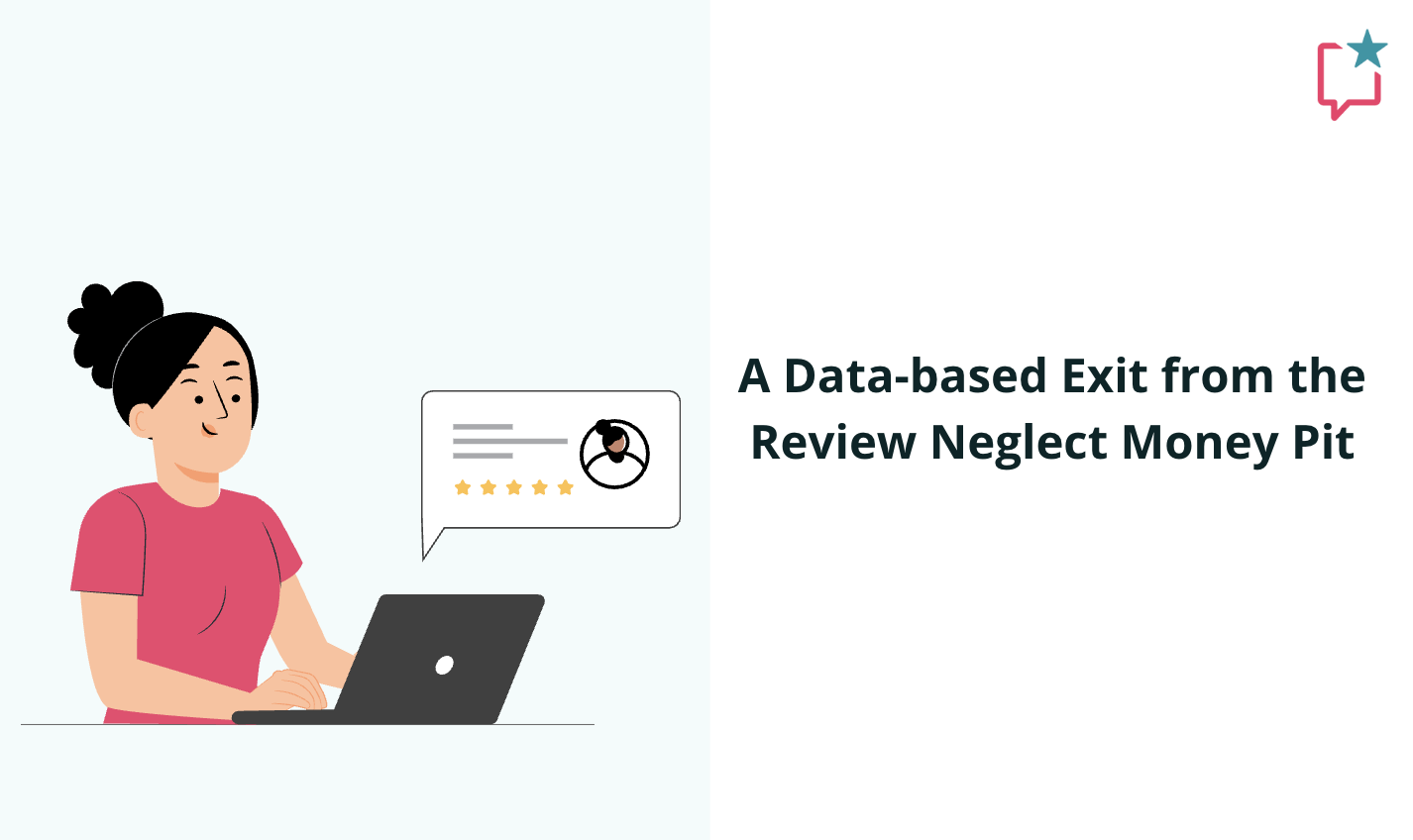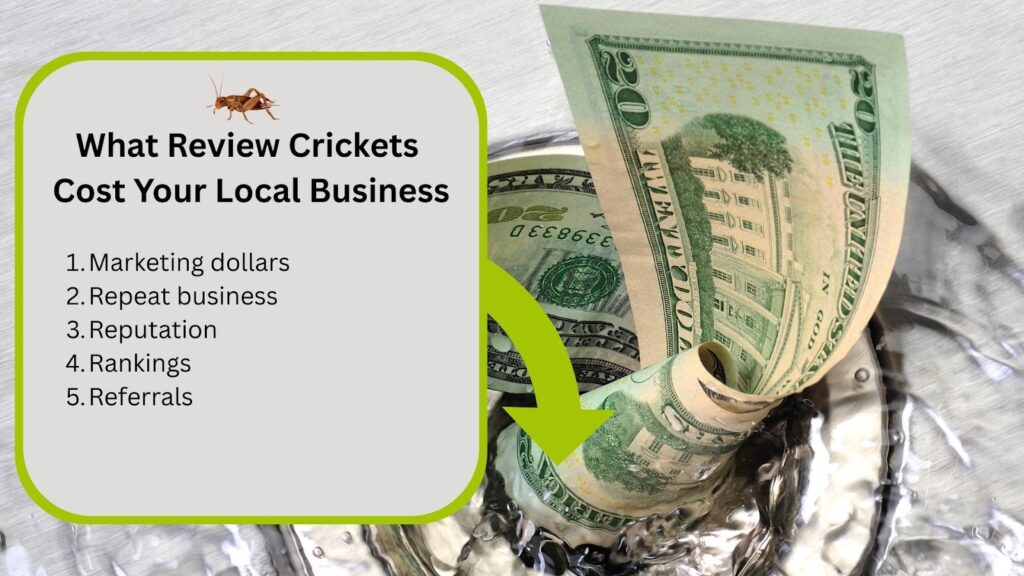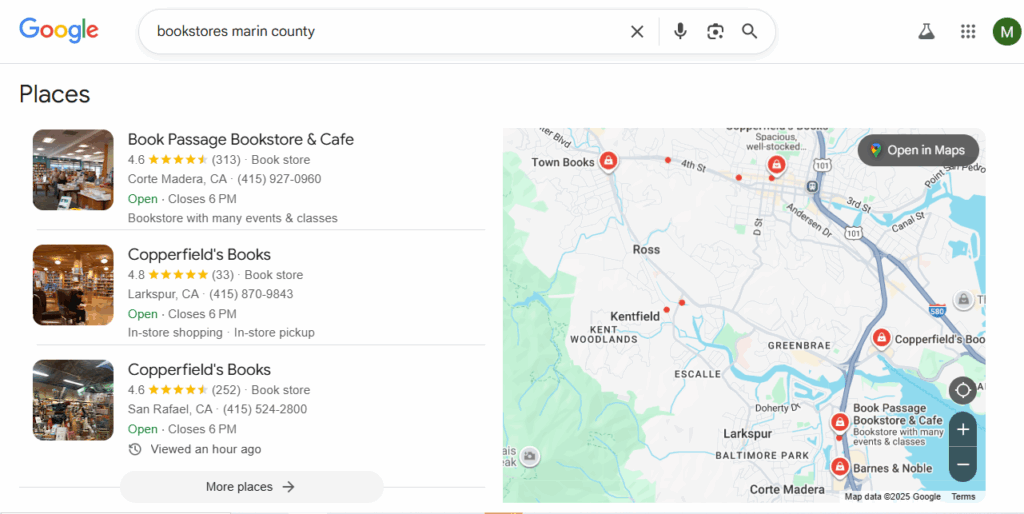
This is a legitimate customer complaint, with a clear explanation of what caused them to leave a one-star review for a branch of an independently-owned local bookstore chain:

This is the response they received from the business:

This is what negative review crickets are costing your business:

Review crickets (failing to respond to both positive and negative online reviews on platforms like Google Business Profile) will quietly drain your business of five of its greatest powers. Neglecting the owner response function on your local business listings creates a vicious cycle of negative outcomes that feed one another as resources slip away, robbing local brands both large and small of the profitable future they could have created.
Today, we’re going to look at fresh, original data from GatherUp’s consumer behavior survey of 1000+ Americans, specifically as it relates to owner responses to reviews, and we’re going to engineer your brand’s exit from this terrible money pit.
All numbers have been rounded up for ease of comprehension.
Counting the real costs of review neglect
So much power slips through your fingers when your brand lacks a standardized process for responding efficiently and effectively to both positive and negative reviews. Here are five very costly outcomes of review neglect:
- Wasted marketing dollars
By the time a customer is writing a review, your brand has already made a significant investment in earning their transaction. This might include, but not be limited to:
- Real-world overheads
- Real-world advertising (billboards, radio, TV, newspapers, etc.)
- Online asset development (website, local business listings, link and unstructured citation building, social media marketing, PPC advertising, etc.)
If all this budget and effort culminates in a single sale which then results in a negative consumer experience and a negative review instead of repeat business, referrals, and a positive review, your resources have been wasted.
- Repeat business
Unless you are selling goods or services that the public only purchases once in a lifetime, your marketing expenditures that result in a first transaction should lead to multiple future transactions as often as possible. You don’t want a consumer base made up of one-time customers. You want lifetime customers who become loyal advocates of your brand in both good times and bad. You are building a community in a specific locality.

A loyal customer base is what will keep you in business and might even bail you out in a future moment of hardship. This is loyalty you can’t afford to lose to review crickets.
- Reputation

The overall star rating of your Google Business Profile (GBP) is an average of all of the ratings customers leave you. According to GatherUp’s survey, 93% of consumers require a rating of 3+ stars in order to choose your business for a transaction. As we can see from the above screenshot, this branch of a well-known pharmacy chain has dipped below the minimum star requirement, meaning that nearly all potential customers will look elsewhere for service. A low-star rating can lead to business closure because the brand simply will not attract enough new business to make up for the customers it has lost to negative experiences.
Each less-than-5-star review you receive erodes your average rating. While just 18% of prospective customers require a perfect 5-star rating to give your business a try, you should be doing everything you can to defend your brand from unresolved complaints.
Even great businesses receive lots of non-5-star reviews, and owner responses are the best avenue for addressing online complaints with such effectiveness that an unhappy customer becomes so impressed with your brand that they update their rating and review. By neglecting these complaints, you are settling for an eroded average rating. The lower it goes, the fewer new customers your location will attract.
- Rankings

While a certain average star rating does not guarantee a specific ranking spot in Google’s local packs and Maps, your rating is strongly believed to be a local search ranking factor. As we can see from the above screenshot, the #1 business has a 4.6 average star rating, while the business sitting at #2 has a slightly higher rating of 4.8. Many factors besides basic rating are at play here, such as user-business proximity and Google’s perception of brand prominence and relevance.
Your potential customers also weigh a variety of factors in choosing which nearby businesses to favor with a visit. If I was looking for a fantastic local bookstore, I might want the highest-rated business rather than the nearest one. Or, I might choose the one with the most reviews, the best photos, or desirable attributes like interesting events or BOPIS fulfillment.
But I won’t be able to make these deliberations as a customer unless your brand is ranking well enough to be visible for my search. Every negative review you turn around with an adept owner response will contribute to your positive average star rating, underpinning your ability to be visible for as many potential customers as possible.
- Referrals

Every day, both online and offline, people start conversations like this one asking others to recommend a favorite business. 60% of consumers say they have depended on word-of-mouth referrals from family and friends to help them choose a local business, and online exchanges of this kind are continuous.
Your business needs to merit this kind of enthusiasm, and if you’re neglecting both positive and negative reviews, you are giving up the power to create an exciting and memorable brand impression. Whether this comes down to writing a really authentic thank you note in an owner response to a positive review, or amazing a negative reviewer with the swiftness and sincerity of your solution to their complaint, you have the ability to stand out on the local commercial scene as a company that deserves to be recommended.
Every new customer you win via referrals contributes to your profits. Every referral you lose to a neglected review undermines profit potentials.
A data-based strategy for plugging into the power of owner responses
94% of consumers place some degree of trust in online local business reviews. It’s hard to think of any other form of content with this level of readership or influence on business outcomes. But the content written by reviewers is incomplete without accompanying content from your business.

GatherUp’s study reveals that 81% of consumers now consider businesses’ responses to online reviews to be part and parcel of offering good modern customer service. If you aren’t responding, it’s like turning your back on a customer who has walked up to you for a conversation in your store or on the job.

Not only do the majority of consumers consider owner responses an essential component of your brand providing good customer service, but 65% say they are more likely to choose a business that is actively responding to its reviews. This is good common sense on the part of the public. Owner responses allow people to preview how your brand treats its customers when things go wrong. If you have neglected negative reviews, you’re sending a massive signal to potential patrons that you will ignore them if they have a legitimate complaint.
Don’t send up that red flag with review crickets. Instead, let GatherUp’s data guide your understanding and strategy for giving customers what they want in response to their reviews.
Acknowledging public praise like a pro

Given the immense influence of reviews on consumer behavior, every positive review you receive should be cause for celebration at your company. More than this, it should elicit genuine heartfelt thanks to the customer who took time out of their busy life to voluntarily write your brand’s most influential sales copy, for free! 73% of consumers say they value a thank-you reply when they leave a positive review.
This is your time to shine. Warmly thank the customer. Tell them it was your pleasure to see them and serve them. Invite them to come again, perhaps to try a new menu item, see a new product, or be part of an upcoming event. Let them know how much you appreciate them telling their friends and family in the community about your local business. Choose words that convey how much you truly value their praise.
Responding powerfully to negative reviews

Negative reviews are the start of a conversation. 72% of negative reviewers expect your brand to respond. Don’t walk away from what is likely your one-time chance to:
- Solve the customer’s problem
- Win them back for future transactions
- Inspire them to update their star rating and review language to reflect an improved subsequent experience with your business
- Refer you to their offline and online circles as a result of the way you took care of them when something went wrong
But, in order for you to transform a negative customer experience into all of these brand benefits, your response must contain a handful of specific elements for maximum result.

This is what negative reviewers and the general review-reading public want from your brand when you respond:
- 64% want you to apologize for the customer’s bad experience
- 66% want you to offer to make things right for the customer by fixing their problem, or offering them a refund or discount
- 44% want you to provide direct contact information so the conversation can be continued offline with a responsible party
- 38% want an explanation of any changes you’ve made at the business to prevent future customers from experiencing the same problem that led to the negative review
- 34% want you to respond quickly
Here is a sample owner response that incorporates all of the above elements:
| Dear Jim,This is Mary Walsh, the owner of Sandcastles Bookstore, and I want to personally let you know how very sorry I am that you came into the shop this morning and found out that your special order had not arrived in the timeframe we quoted you. We had a problem with this particular distributor that came as a surprise to us. I’m also sorry that you then had to pay extra for a rush order to get the book delivered as soon as possible. This is my fault – I need to do a better job training my staff to escalate a problem like this directly to me, and I will be holding an all-staff meeting this week to ensure this doesn’t happen to future valued customers like you. Would you please give me the opportunity to make this right for you? I really regret the inconvenience to you and the disappointment you felt. If you would please call me directly at 1-333-222-1111, I will refund the amount you paid for rush shipping, and I would also like to offer you a 10% discount coupon for your next purchase. It means so much to me to serve a neighbor like you, and I want to do anything I can to make this right. I will be hoping to hear from you, and to have the opportunity of apologizing in person when you pick up your book. I hope you can find it in your heart to reach out. Thank you. Sincerely,Mary Walsh, OwnerSandcastles Bookstore |
Our sample response shows an owner who caught the negative review and replied to it on the same day. Depending on your business model, the ideal response time may vary, but here is what the data says about general response time expectations when a negative review occurs:

- 22% expect a same-day response
- 36% expect a response within 2-3 days
- 23% expect a response within a week
- 4% expect a response within two weeks
- 2% expect a response within a month
A good rule of thumb is to reply as quickly as possible, and to avoid taking longer than 3 days to respond. The window of opportunity is brief to correct course with a customer and win them back.
If you perfect your owner response strategy, both in terms of response content and timing, you can expect the benefits to begin flowing in. Here are the great things that can happen for your brand when you get this right:

When you resolve a review complaint:
- 69% of customers will give your business a second chance
- 47% will update their review and rating to reflect an improved opinion of your business
- 32% will recommend your business to others because of how you handled their complaint
- 21% will feel increased loyalty to your brand going forward
Why these are numbers you can’t afford to ignore
Imagine what it would do to your current customer churn rate if nearly 7 in 10 of your unhappy customers came back for future transactions instead of permanently walking away.
Imagine what it would do to your average star rating if nearly half of your negative reviews turned into positive ones, thanks to your responses.
Imagine if 3/10 customers who were upset enough about an experience with your business to negatively review it were transformed into brand evangelists who were actively giving you referrals.
Imagine if 2/10 former brand detractors suddenly decided they liked you enough to become long-term or lifetime loyal customers.
These numbers quickly add up to an escape from major drains on your resources and revenue. They offer tremendous opportunities for improved reputation, rankings, retention, referrals, and revenue. Every unhappy customer counts so much in this dynamic, and there is real potential to transform them into a neighbor who trusts your brand and returns to it, time and again.
But this is just the start of the role reviews play in shaping and facilitating a wide variety of today’s consumer behaviors. For the full statistics and an actionable, data-based, local search marketing strategy, review Beyond the Stars full report.
